Learn
Toolmark Identification
A tool is something hard which will make a mark in a softer surface when they are brought in contact, this mark is known as a "toolmark." Tools have unique, microscopic characteristics that arise both from their manufacturing (class characteristics) and wear and tear (individual characteristics). When the tools leave their marks, these characteristics can be seen there as well; it's as if the tool is leaving a fingerprint at the scene.
The goal of the toolmark examiner is to compare the striations and impressions left by the tool to the tool itself or to other marks that may have been made by the same tool.
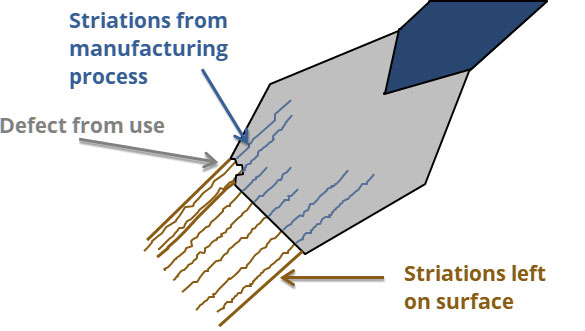
Toolmark Striations
When a tool is used, it can leave striations marks or impressions.
Striation marks arise when a tool is moved parallel across another with pressure applied; scratching and slicing are two examples.
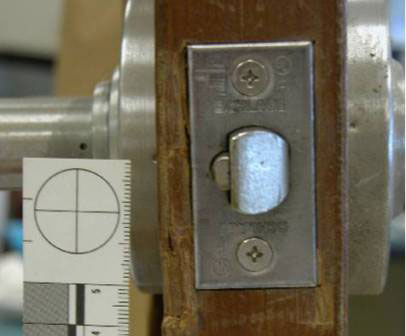
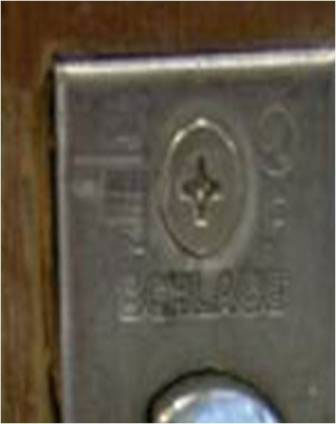
Toolmark Impressions
Impression marks are made when a tool is placed against another and enough force is applied perpendicular to leave a three dimensions indentation. For example, a crowbar being used to pry open a door may leave an impression.
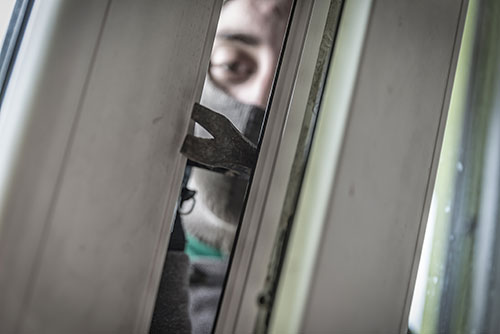
Knowledge Check #1
Are the toolmarks left by these pliers an example of a striation or impression?

- Striation
- Impression
Answer: b. Impression. These are three dimensional indentations.
Class and Individual Characteristics
These striations and impressions show the variations on the surface of the tool.
- The tool will contain class characteristics, which are planned by the manufacturer, such as the width, length, and shape of the tool.
- The tool will also contain incidental marks or individual characteristics. These are not planned and occur during manufacturing or because of tool use.
Class characteristics are generally more readily identifiable while individual characteristics are typically microscopic and not visible until professional analysis occurs.
Knowledge Check #2
For example, it may be obvious from an impression that it was made by a crowbar of a particular size (which is a _______blank) but the scratches and corrosion on the crowbar (which are _______blank) will not be immediately obvious in the print.
Answers: blank 1: class characteristic and blank 2: individual characteristics
Collecting Toolmark Evidence
Tools themselves should be collected and properly packaged if found at the crime scene. Tools may contain trace evidence such as paint, blood, or hair. Care should be taken not to disturb these. These will be collected at the lab prior to analysis of the tool. Fingerprint analysis may also be performed at the lab before examination of the tool.
While it may be tempting to place a tool into a suspected impression to see if they match, this could damage both the impression and tool.
Toolmarks can be collected by removing the material that contains the toolmarks (if possible) for transportation to the lab, photographing the toolmark with a scale, or making a cast of the impression. According to the Minnesota Department of Public Safety, "Silicone based casting material can be used to capture the surface features of a variety of impressions encountered at crime scenes. The resulting casts preserve the details of the various marks and can be used by the Firearm and Toolmark Section for comparative examinations back at the Laboratory."
Knowledge Check #3
Which of these is not acceptable at the scene of the crime?
- Taking photos of toolmarks with a scale
- Placing a tool in a toolmark to see if they match
- Taking an impression of a toolmark with silicone
- Removing something from the scene, such as a broken piece of a doorframe, that contains a toolmark and packaging it to take to the lab
Answer: b. Placing a tool in a toolmark to see if they match
Toolmark Analysis
Toolmark analysis generally occurs in the same unit as firearm analysis. This video from the Denver Police shows some examples of toolmark evidence as well as the main instrument used to analyze this evidence.
Watch from 0:53 to 1:03 and then from 1:48 to 2:04.
Open Inside the Crime Lab: Firearms and Toolmark Unit in a new tab
Knowledge Check #4
What is the main tool used by toolmark examiners?
- Electron microscope
- Comparison microscope
- Dental molds
- Magnifying glass
Answer: b. Comparison microscope
When comparing toolmarks, examiners may have two different marks which they are comparing side-by-side to determine if they came from the same tool. They would place both in the comparison microscope and perform their analysis.
If examiners are comparing unknown marks to a known tool, they will need to create toolmarks for side-by-side comparison.
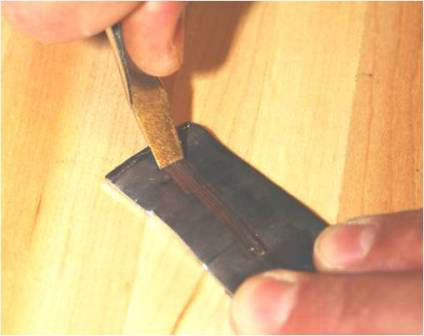
When making these test marks, the examiner should consider and attempt to replicate several variables such as the direction in which the tool moved, the amount of force used, and the angle and orientation of the tool. To avoid altering the tool when creating test marks, a softer material such as sheet lead should be used.

Pattern Matching
According to the National Forensic Science Technology Center, "Pattern matching is the process of determining whether or not the details of striated marks or impressions on two objects correspond. The examiner compares the class characteristics of the two objects; if all class characteristics correspond, the examiner proceeds to compare the individual characteristics. During the comparison of the individual characteristics, the examiner looks for repetitive marks occurring on both objects in the same location and position."

Subjective vs. Objective
"This is a somewhat subjective (based on or influenced by personal feelings, tastes, or opinions) process performed by the examiner. Pattern identification relies on the experience, training, and education of the examiner. The quality of training is the single most important element of the examiner's competence and expertise. Long-term hands-on experience is gained from working side-by-side with an experienced examiner in a structured training program" (Dillon).
To increase the objectivity (dealing with facts or conditions without distortion by personal feelings, prejudices, or interpretations) of these analyses, examiners have begun using a more quantitative method known as consecutive matching striae (CMS). While traditional pattern matching relied on qualitative descriptions, CMS requires examiners to count the number of matching striations that they find in a row on the two toolmarks they are comparing. While not practiced by all examiners, CMS values tend to increase the credibility of examiners when presenting their findings in the court of law.
When comparing two impressions, at least six consecutive matching striations or two groups of three consecutive matching striations are necessary to identify two marks as being from the same tool.
For striations, at least eight matching striations must be present or two groups of five.
Knowledge Check #5
If possible, which type of evidence should be presented in the court of law?
- Objective, Qualitative
- Objective, Quantitative
- Subjective, Qualitative
- Subjective, Quantitative
Answer: b. Objective Quantitative. Quantitative measurements help to decrease the subjectivity of toolmark examination.
Knowledge Check #6
Which type of toolmarks require more consecutive matching striations to declare they came from the same tool?
- Impressions
- Striations
- Both types require the same number of consecutive matching striations.
Answer: b. Striations
Measuring with Calipers
Toolmark examiners typically use compound microscopes, but they sometimes use low magnification and special lighting. They may physically place the items side-by-side for comparison or place digital images side-by-side on large computer monitors for comparison. Calipers are used to collect precise measurements which provide a quantitative means of comparing the toolmarks.
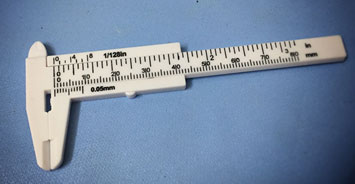
A caliper fits around or inside the object you are measuring, or the mark it left. The hundredths place is determined by finding where the lines on the sliding portion align with the stationary component of the caliper.The "jaws" of the caliper could be placed around the toolmarks to measure different aspects of the impressions or striation. To improve accuracy, some calipers come with a digital screen that lists the exact measurement.

This animation shows how a Vernier caliper can be used to measure a nut.

Conclusions
After comparison, the examiner may come to one of four conclusions:
- Identification: The agreement between the marks and/or tool exceeds that which would occur if the toolmarks were made by different tools.
- Inconclusive: Agreement between all class characteristics but insufficient evidence of individual characteristic agreement.
- Elimination: Significant disagreement between class or individual characteristics
- Unsuitable: Toolmarks do not have enough marks for comparison or the marks are too small/fragmented.
These conclusions are defined by the Association of Firearm and Tool Mark Examiners (AFTE), the professional organization which sets standards and issues certification for firearm and tool mark examiners.
Knowledge Check #7
Several railroad spikes bear marks showing they were removed by a tool that utilizes prying action. However, there were not enough microscopic marks on the spikes to determine if the submitted tool was the one used. Which conclusion should the examiner classify this situation under?
- Identification
- Inconclusive
- Elimination
- Unsuitable
Answer: b. Inconclusive
Knowledge Check #8
Crime scene investigators found a padlock at the scene and submitted it for analysis. Toolmark examiners reported that it did not contain microscopic marks that were of value for comparison purposes. What type of conclusion is this?
- Identification
- Inconclusive
- Elimination
- Unsuitable
Answer: d. Unsuitable
Credits
Dillon, Jack. "Pattern Identification." Firearm Examiner Training (2008), Module 13: Toolmark Identification, National Forensic Science Technology Center, https://projects.nfstc.org/firearms/module13/fir_m13_t05_05.htm.
"Silicone Based Casting Materials", Forensic Science Services, Bureau of Criminal Apprehension, Minnesota Department of Public Safety, https://dps.mn.gov/divisions/bca/bca-divisions/forensic-science/Pages/forensic-programs-crime-scene-silicone.aspx.